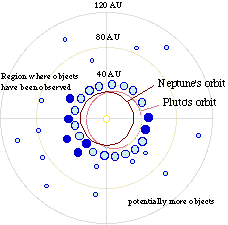Exploratour - Evolution of the Solar System
This is a drawing which shows where the Kuiper Belt may be located.
Click on image for full size
Click on image for full size
This picture shows the region of space where the Kuiper Belt is. In this picture, the observer is looking down on the solar system from above. The picture shows a region from the sun to 120 AU. The earth is so close to the center of the drawing that it does not show up.
This region is sometimes called "trans-Neptunian space" because even the planet Pluto could really be part of the Kuiper Belt.
This is page 16 of 60












